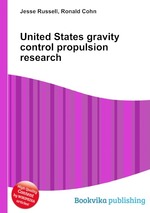United States gravity control propulsion research
Jesse Russell Ronald Cohn
бумажная книга
High Quality Content by WIKIPEDIA articles! American interest in "gravity control propulsion research" intensified during the early 1950s. Literature from that period used the terms anti-gravity, anti-gravitation, baricentric, counterbary, electrogravitics (eGrav), G-projects, gravitics, gravity control, and gravity propulsion. Their publicized goals were to develop and discover technologies and theories for the manipulation of gravity or gravity-like fields for propulsion. Although general relativity theory appeared to prohibit anti-gravity propulsion, several programs were funded to develop it through gravitation research from 1955 to 1974. The names of many contributors to general relativity and those of the golden age of general relativity have appeared among documents about the institutions that had served as the theoretical research components of those programs. The existence and 1950s emergence of the gravity control propulsion research had not been a subject of controversy for aerospace writers, critics, and conspiracy theory advocates. But its rationale, effectiveness, and longevity have been the objects of contested views.


